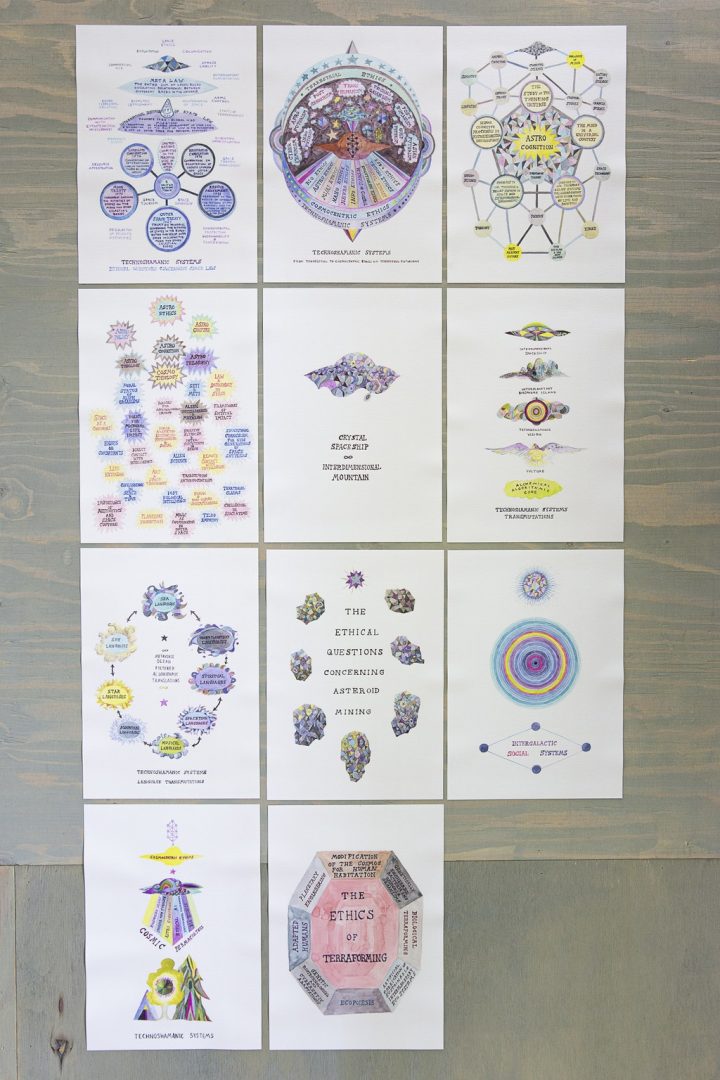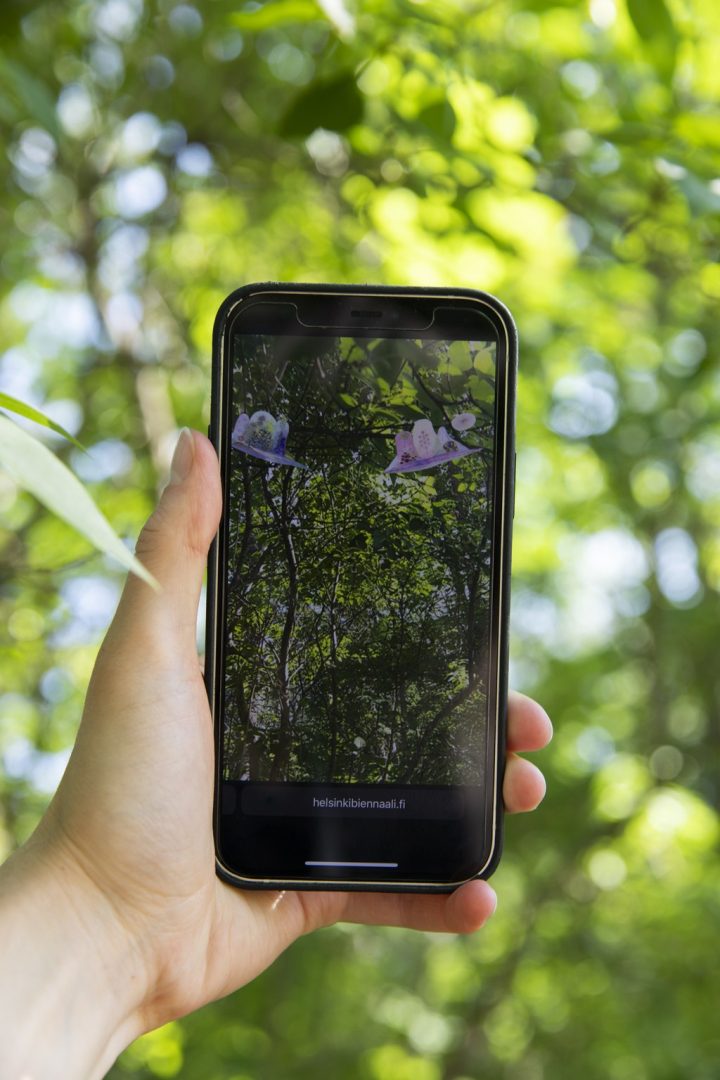Suzanne Treister was initially recognized as a painter but became a pioneer in digital media and web-based art in the early 1990s. Her extensive body of work comprises eccentric narratives and unconventional bodies of research revealing structures that bind together power, identity, and knowledge systems. Her projects consist of fantastical reinterpretations of given taxonomies and histories that examine the existence of covert, unseen forces at work in the world, whether corporate, military, or paranormal.
Installed in a wooden cabin on Vallisaari Island, Technoshamanic Systems (2020-21) presented microcosmic non-colonialist plans for a techno-spiritual imaginary of alternative visions of survival on earth and inhabitation of the cosmos. Treister’s work encourages the unification of art, spirituality, science, and technology through hypnotic visions of our potential communal futures alongside those of possible extraterrestrial entities or civilizations.
Treister’s watercolour paintings were accompanied by a new AR component in which the Interplanetary Meditation and Biospheres Islands appear to float high up in the sky.
On the 8th of April 2020, I found myself reading a newspaper article headlined “Trump order encourages US to mine the moon. Executive order says US will oppose any effort to bar it from removing chunks of moon, Mars or elsewhere in space”. The article noted that the US had never signed the 1979 moon treaty which stipulates that any activities in space should conform to international law. In 2015 the US Congress had passed a law allowing companies to use resources from the moon and asteroids.
In January I had been to the exhibition Moving to Mars at London’s Design Museum, which showed models of potential Martian settlements. Looking deeper into the ambitions of the private space industry, of Elon Musk, Richard Branson and numerous private ventures and corporations, it became clear that the history of colonization was far from over and that a sector of humanity was working towards a potential occupation and destruction of the rest of the Universe. Assuming the development of the associated technologies could not be stopped, there needed to be not only movements against oppression and destruction on Earth, but also people developing models and ethical frameworks for potential non-colonialist techno-spiritual futures of humanity in space.
Imagining positive visions for the future of life on our planet, this project is my attempt to contribute to the emerging fields of astrocognition, astroethics and astrobioethics.
N.B. My use of the term Technoshamanic in the title of this project aims to expand and redefine its current definition, enabling it to act cosmically as a term that encompasses a worldview where technology, instead of being driven by mainstream economic, corporate and governmental forces, is engineered and redirected in new ways for global positive futures.
Suzanne Treister

Suzanne Treister, TECHNOSHAMANIC SYSTEMS New Cosmological Models for Survival TEKNOSHAMANISTISIA JÄRJESTELMIÄ Uusia kosmologisia eloonjäämisen malleja, 2020-2021, Helsinki Biennial 12.6.-17.9.2023, Vallisaari, Helsinki, Photo: © HAM/Helsinki Biennial/Sonja Hyytiäinen

Suzanne Treister,
TECHNOSHAMANIC SYSTEMS New Cosmological Models for Survival
TEKNOSHAMANISTISIA JÄRJESTELMIÄ Uusia kosmologisia eloonjäämisen malleja, 2020-2021, Helsinki Biennial 12.6.-17.9.2023, Vallisaari, Helsinki, Photo: © HAM/Helsinki Biennial/Sonja Hyytiäinen

Suzanne Treister,
TECHNOSHAMANIC SYSTEMS New Cosmological Models for Survival
TEKNOSHAMANISTISIA JÄRJESTELMIÄ Uusia kosmologisia eloonjäämisen malleja, 2020-2021, Helsinki Biennial 12.6.-17.9.2023, Vallisaari, Helsinki, Photo: © HAM/Helsinki Biennial/Sonja Hyytiäinen
Treister’s recent solo and group exhibitions include: 7th Athens Biennale, Greece; Muzeum Sztuki, Lodz, Poland; 34th Ljubljana Biennale of Graphic Arts; Kunstmuseum Appenzell, Switzerland (2021); Schirn Kunsthalle, Frankfurt; Yerevan Biennial, Armenia (2020); Istanbul Biennial, Turkey; Moderna Museet, Stockholm, Sweden (2019); Busan Biennale, Korea; CAPC, Bordeaux, France; EKKM, Tallinn, Estonia; CCCB, Barcelona; ZKM, Karlsruhe, Germany (2018); IMMA, Dublin; Haus der Kulturen der Welt, Berlin; Montreal Museum of Fine Arts, Canada (2017); P.P.O.W., New York; Liverpool Biennial, UK; V&A Museum, London; Bildmuseet, Umea, Sweden; Bard Hessel Museum, NY, USA (2016); ICA, London, England; Centre Pompidou, Paris; Kunstverein München, Germany; Stedelijk Museum Bureau Amsterdam (SMBA), Netherlands; Thyssen-Bornemisza Art Contemporary, Vienna; HMKV, Dortmund, Germany (2015); 10th Shanghai Biennale; 8th Montréal Biennale (2014)
Suzanne Treister
TECHNOSHAMANIC SYSTEMS New Cosmological Models for Survival
2020-2021
site specific installation: Wooden recyclable forest hut structure, 185 digital prints from original watercolours – each 21 x 29.7 cm, augmented reality.
The project comprises Project Diagrams, Earth Eco Systems and Architectures, Reinvented Technologies, Interplanetary Social Structures, Designs for Spacecraft, Apparel, Interplanetary Space Habitations, Interplanetary Meditation and Biospheres Islands, Crystal Architectures, Vultures, Rituals, Stars and Visions.
Realisation of AR: James Wreford
Courtesy the artist, Annely Juda Fine Art, London and P.P.O.W. Gallery, New York